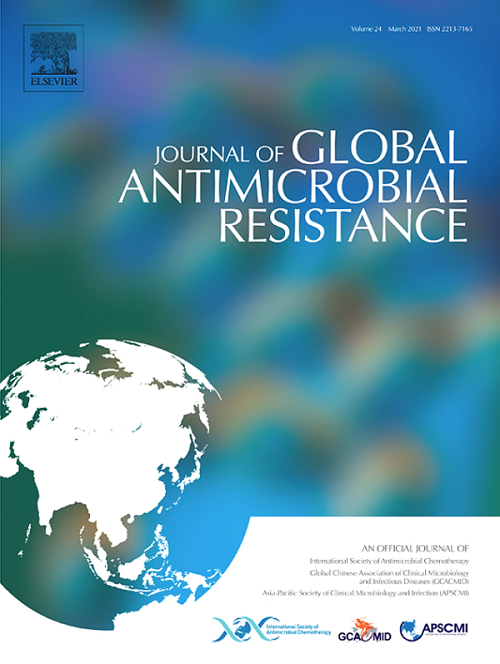Emerging resistance to novel β-lactam β-lactamase inhibitor combinations in Klebsiella pneumoniae bearing KPC variants
IF 3.2
3区 医学
Q2 INFECTIOUS DISEASES
引用次数: 0
Abstract
Objective
Klebsiella pneumoniae carbapenemase (KPC) variants, predominantly KPC-2 and KPC-3, are significant global resistance mechanisms, conferring resistance to many β-lactams, including carbapenems, while remaining susceptible to ceftazidime-avibactam (CZA). Recently, new KPC variants have developed resistance to CZA through mutations, insertions, or deletions in regions such as the Ω-loop, 240-loop (237–243 aa), and 270-loop (266–275 aa). This study investigated collateral resistance to cefiderocol (FDC) and cefepime/zidebactam (FPZ) in isolates with these mutations.
Methods
Fifteen clinical KPC-producing Klebsiella spp. isolates representing 15 distinct variants were analysed. Antimicrobial susceptibility testing determined the MICs for CZA, carbapenems, FDC, FPZ, and other antibiotics. Synergy between CZA and FDC was assessed. Whole-genome sequencing (WGS) was used to identify resistance-related mutations.
Results
CZA resistance was confirmed in 12/15 variants. Collateral resistance to FDC occurred in eight isolates, with five exhibiting spontaneous resistant subpopulations. Six FDC-resistant strains had mutations in the 270-loop (266–275 aa). FPZ resistance was seen in three KPC variants, especially those with mutations in the 270-loop, though many Ω-loop and 240-loop (237–243 aa) mutants remained susceptible. WGS of FDC-resistant subpopulations revealed additional mutations in ompC, rpoC, dksA, and cirA.
Conclusions
Emerging CZA-resistant KPC variants often exhibit collateral FDC resistance, with FPZ seen less frequently. Mutations in blaKPC, cirA, and other genes contribute to resistance. Understanding these emerging resistant patterns linked with new KPC variants is crucial to inform therapeutic decisions, as emerging resistance may limit last-line treatment options in clinical settings.
携带KPC变异的肺炎克雷伯菌对新型β-内酰胺β-内酰胺酶抑制剂组合的新耐药性
背景:肺炎克雷伯菌碳青霉烯酶(KPC)变体,主要是KPC-2和KPC-3,是重要的全球耐药机制,赋予许多β-内酰胺类,包括碳青霉烯类耐药,同时对头孢他啶-阿维巴坦(CZA)敏感。最近,新的KPC变体通过Ω-loop、240环(237-243 aa)和270环(266-275 aa)等区域的突变、插入或缺失,对CZA产生了抗性。本研究调查了具有这些突变的分离株对头孢地罗(FDC)和头孢吡肟/齐地巴坦(FPZ)的附带耐药性。方法:对临床分离的15株产kpc克雷伯氏菌进行分析。药敏试验测定CZA、碳青霉烯类、FDC、FPZ等抗生素的mic。评估CZA和FDC之间的协同作用。采用全基因组测序(WGS)鉴定耐药相关突变。结果:12/15个变异株均有CZA耐药。8个分离株发生了对口蹄疫的附带抗性,其中5个表现出自发抗性亚群。6株fdc耐药菌株在270环(266-275 aa)发生突变。在三种KPC变异体中发现了FPZ耐药性,尤其是那些270环突变体,尽管许多Ω-loop和240环(237-243 aa)突变体仍然易感。fdc耐药亚群的WGS显示,在ompC、rpoC、dksA和cirA中存在额外的突变。结论:新出现的对cza耐药的KPC变体通常表现出伴随的FDC耐药,而FPZ的出现频率较低。blaKPC、cirA和其他基因的突变有助于产生耐药性。了解这些与新的KPC变体相关的新出现的耐药模式对于告知治疗决策至关重要,因为新出现的耐药可能限制临床环境中的最后一线治疗选择。
本文章由计算机程序翻译,如有差异,请以英文原文为准。
求助全文
约1分钟内获得全文
求助全文
来源期刊

Journal of global antimicrobial resistance
INFECTIOUS DISEASES-PHARMACOLOGY & PHARMACY
CiteScore
8.70
自引率
2.20%
发文量
285
审稿时长
34 weeks
期刊介绍:
The Journal of Global Antimicrobial Resistance (JGAR) is a quarterly online journal run by an international Editorial Board that focuses on the global spread of antibiotic-resistant microbes.
JGAR is a dedicated journal for all professionals working in research, health care, the environment and animal infection control, aiming to track the resistance threat worldwide and provides a single voice devoted to antimicrobial resistance (AMR).
Featuring peer-reviewed and up to date research articles, reviews, short notes and hot topics JGAR covers the key topics related to antibacterial, antiviral, antifungal and antiparasitic resistance.
 求助内容:
求助内容: 应助结果提醒方式:
应助结果提醒方式:


